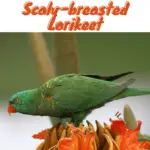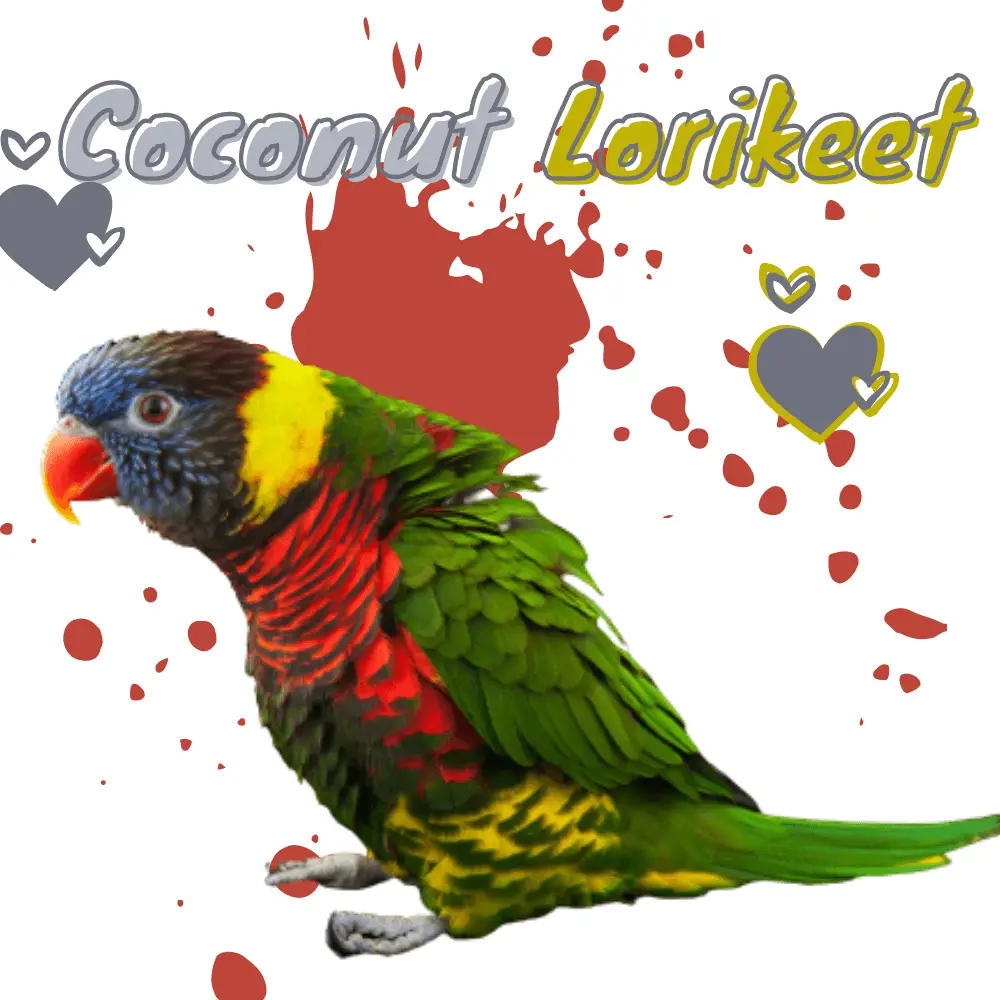
Coconut Lorikeet 25–30 cm; 109–137 g. Bill orange to red; head blue to deep brown lightly flecked pale violet; nuchal collar yellow; rest of upperparts and tail green, latter dusky yellow below;
breast red barred blue-black; belly dark green; thighs and under tail-coverts yellow barred dark green; underwing-coverts orange with broad yellow underwing bar.
Immature duller, bill brownish. Races exhibit various permutations of basic haematodus coloration, e.g. different intensities and extent of blue on the head, of the color of belly, barring on breast: intermedius is sometimes considered synonymous with the nominate, being so similar;
nigrogularis differs from nominating by more orange breast with narrower barring, center of belly blackish and paler blue streaking on the head;
micropteryx is intermediate between nominate and Massena, being smaller and paler than the former, with a more orange breast and narrower barring;
nesophilus is very similar to flavicans (which see), but never has upperparts bronze-yellow;
flavicans is similar to nominate, but shows some reddish on vent and thighs, has entire upperparts varying between bronze-yellow to green (former color morph has hind collar yellow),
nape purplish tipped reddish-brown, forehead and lores bright violet-blue, rest of head dark purple streaked grey-green on the center of the crown, and has red marks at the edge of hind collar; Massena is also similar to nominate,
but has barring on breast narrower and more broadly spaced, more restricted red on underparts (not reaching flanks and upper belly), and is also like micropteryx,
but has hind collar less yellowish and strong purplish-brown tinge on nape; and deplanchii is distinguished from nominating by the paler blue head, greener hind collar,
scarlet-crimson breast with narrower dark barring, pale green streaking on rear crown and head-sides, and also has narrower barring than Massena.
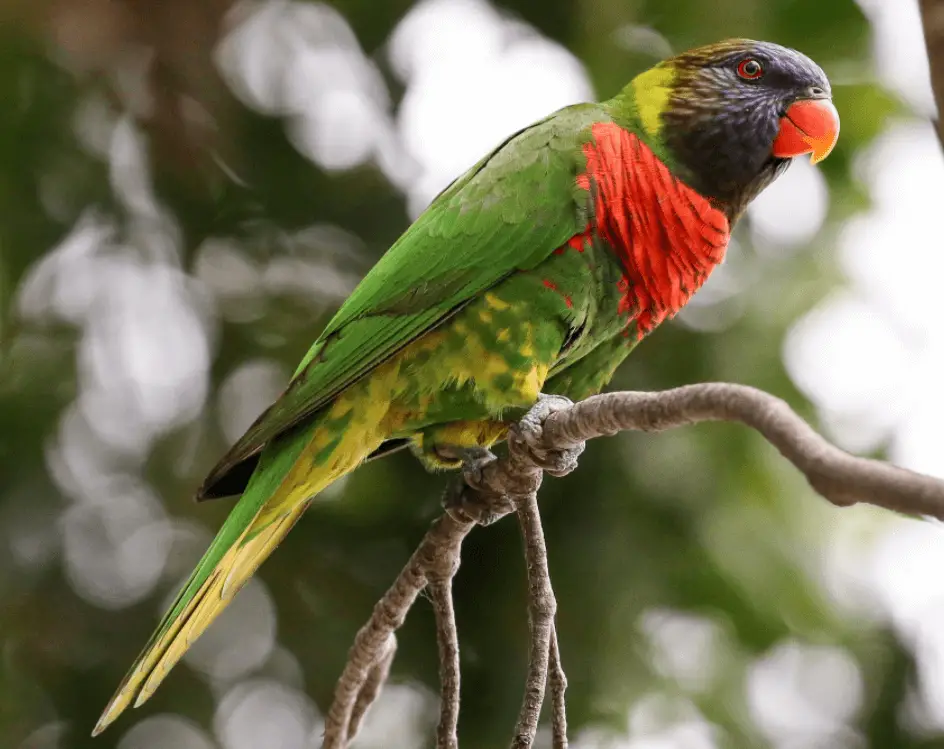
Editor’s Note: This article requires further editing work to merge existing content into the appropriate Subspecies sections. Please bear with us while this update takes place.
With one exception, has hitherto been considered a much more widespread species that included T. forsteni, T. weberi, T. capistratus, T. rosenbergii, T. moluccanus and T. rubritorquis (which see).
Subspecies
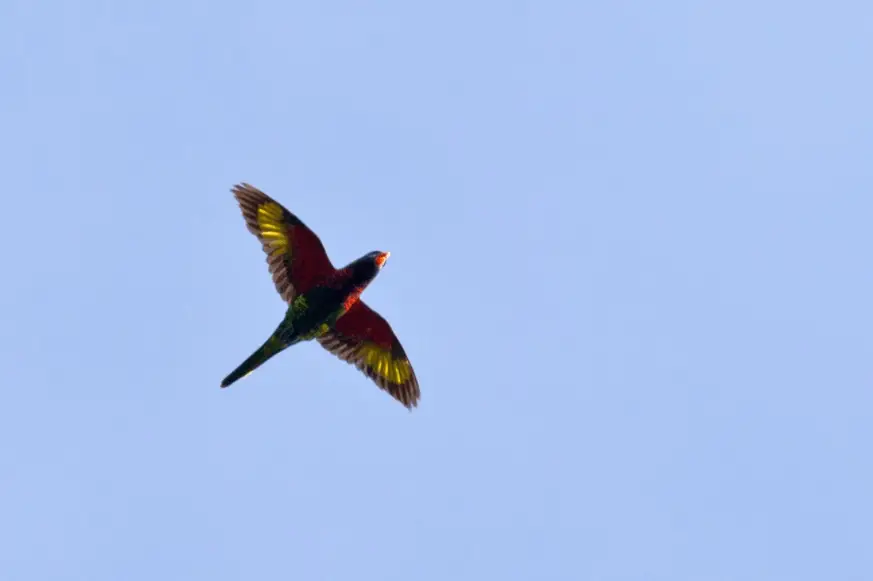
Coconut Lorikeet (Biak)Trichoglossus haematodus rosenbergii Scientific name definitions
Distribution
Coconut Lorikeet (Coconut)Trichoglossus haematodus [haematodus Group]
Trichoglossus haematodus intermedius Scientific name definitions
Distribution
Trichoglossus haematodus haematodus Scientific name definitions
Distribution
Trichoglossus haematodus nigrogularis Scientific name definitions
Distribution
Trichoglossus haematodus brooki Scientific name definitions
Distribution
Trichoglossus haematodus nesophilus Scientific name definitions
Distribution
Trichoglossus haematodus flavicans Scientific name definitions
Distribution
Trichoglossus haematodus massena Scientific name definitions
Distribution
Trichoglossus haematodus micropteryx Scientific name definitions
Distribution
Trichoglossus haematodus deplanchii Scientific name definitions
Distribution
Distribution
Editor’s Note: Additional distribution information for this taxon can be found in the ‘Subspecies’ article above. In the future we will develop a range-wide distribution article.
Habitat
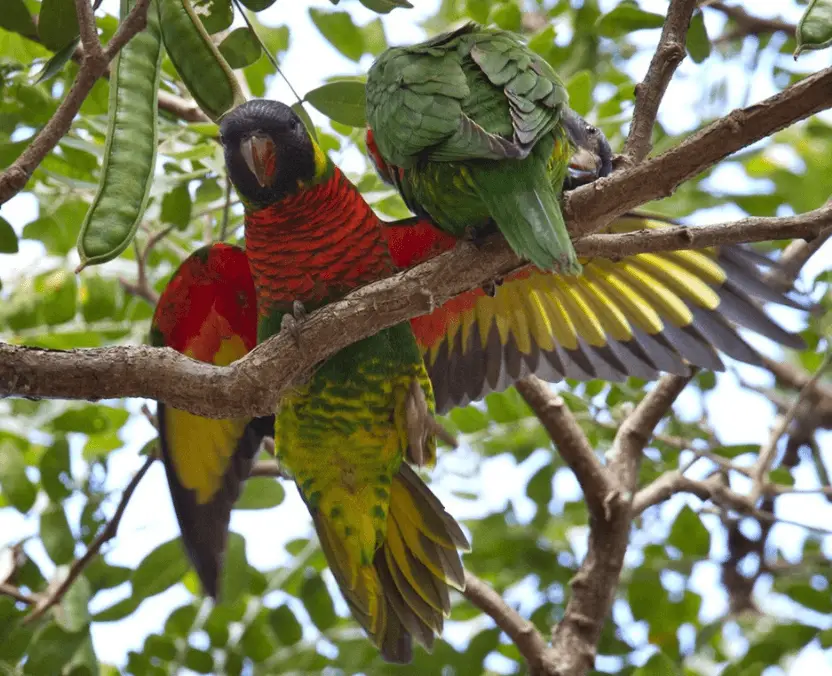
Most types of lowland and lower montane wooded country, including mangroves, nypa forest, freshwater swamp forest, primary rain forest, secondary growth, scrubby monsoon forest, savanna, riparian woodland, mallee, coconut and other plantations, gardens, and suburban areas;
tends to favor edges and disturbed vegetation rather than the interior of closed-canopy formations. Coconut Lorikeets at least visit but perhaps also survive year-round in scrub and plantations on very small atolls.
Typically from sea-level to 500–700 m, but often higher depending on the island, e.g. 1400 m on Seram, c. 1900 m on New Britain, and 2440 m in one part of New Guinea, but confined to coastal lowlands on Buru.
On Kolombangara densities are higher in montane (900–1200 m) than in lowland forest, in contrast to Chalcopsitta cardinalis; in New Caledonia, this species prefers favored areas at low altitudes with minimal rainfall and mesotrophic soils.
Movement
Local abundance on tropical islands may vary considerably with the phenology of flowering trees, but in some places, e.g. C New Guinea, the species has been judged sedentary,
although even in areas where the species is considered a permanent resident it tracks flowering events by favored trees.
On groups of small islands birds commonly move from one to the other daily. Daily movements to offshore islands to and from feeding/roosting areas occur.
Diet and Foraging
Coconut Lorikeet Diet is comparatively poorly known compared to T. moluccanus, although presumably similar to both latter and other members of the superspecies.
Observed feeding on Casuanna on Buru and flowers of the genus Melicope in Papua New Guinea. In New Britain, observed feeding together with Charmosyna rubrigularis. Tends to form larger flocks in the non-breeding season.
Sounds and Vocal Behavior
Sharp rolling screeching calls (e.g. “peaow-peaow-peaow”), given at regular intervals in flight, as well as shrill chattering notes while feeding, a soft twittering at rest, and a loud clear musical call.
Vocalizations are similar to but generally deeper than Glossopsitta concinna, louder than Neopsittacus musschenbroekii, and less hoarse and grating than those of Pseudeos fuscata.
Breeding
Activity throughout most of the year in New Guinea; nest-prospecting Nov–Dec on Buru; Aug–Jan in Vanuatu; Sept–Feb in New Caledonia; in Solomons Aug, when copulation and nests with chicks observed,
but also Nov. Coconut Lorikeet Nest in a deep unlined hole in the limb or trunk of a large tree,
sometimes sharing the same tree with other hole-nesting species such as Sulphur-crested Cockatoo (Cacatua galerita); exceptionally, on Manus (Admiralty Is),
Coconut Lorikeet / Green Naped Parakeet in Bannerghatta National Park Bannerghatta Biological Park
SOURCE: SUBBALAKSHMI SASTRY
Coconut Lorikeet nests in the ground in excavated holes up to 1 m deep on tiny predator-free offshore islets, but also observed apparently nesting in tree-holes in late Mar on Rara I, within the same archipelago.
Eggs 1–3, size (in captivity) 26·9 mm × 21·7 mm (race haematodus), 27·3–30·6 mm × 21·4–23·9 mm (race nigrogularis), 28·9 mm × 24·1 mm (race flavicans); incubation lasts c. 25 days; nestling period 7–8 weeks.
Conservation Status
Not globally threatened (Least Concern). CITES II.
Trapping has rendered the population on Ambon very small. Abundant, Seram. Apparently uncommon on Kai Is, with just two recent observations, and no recent records on Kisar, where perhaps only ever an exceptional visitor.
Abundant throughout much of New Guinea, and considered possibly the commonest parrot on the island; as many as 80 birds/km² are estimated in one area of SE New Guinea. Common, Karkar. Common, New Britain, especially in the lowlands and foothills.
Abundant, New Georgia. Widespread in small numbers, Bougainville; elsewhere considered abundant in N Solomons.
Fairly common, New Caledonia and adjacent islands, were introduced on Ouvea in the 1970s, as well as in the uplands of Santo, Vanuatu. At least in Indonesia, the species may increase in response to selective logging.
The world population of entire T. haematodus superspecies estimated at 5,000,000 birds in the late 1990s, of which the majority presumably present species and T. moluccanus.
The beak and feather disease virus has been identified in this species in New Caledonia, but to date not in any of the archipelago’s other psittacine species.


